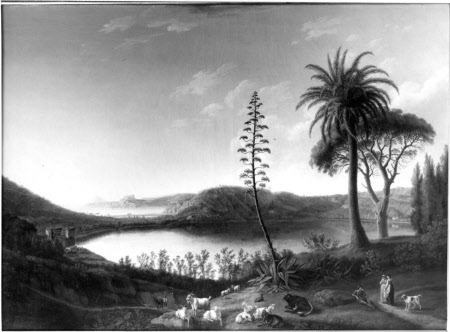The Lake of Avernus
Jakob Philipp Hackert (Prenzlau 1737 – San Piero di Careggi 1807)
Category
Art / Oil paintings
Date
1800 (signed and dated)
Materials
Oil on canvas
Measurements
1194 x 1676 mm (47 x 66 in)
Order this imageCollection
Attingham Park, Shropshire
NT 609001
Caption
The extraordinary beauty of Lake Avernus, without doubt the most charming of the Phlegraean lakes, appeared in many sketchbooks of the various vedutisti of the Grand Tour. Here its silent magnificence is tangible. Travellers used the Roman poet, Virgil, as their guide while following in Aeneas’s footsteps along its banks. According to the epic poem, this is the dwelling place of the Cimneri, who never saw the sun, and visitors were convinced they recognised the grotto of the Cumaean Sibyl and the entrance to Hades. This view, completed after the artist's departure to Tuscany because of the French occupation of Naples is one of the 2nd Lord Berwick’s Grand Tour souvenirs. It is seen from what is now the road between Naples and Rome, which passes the Arco Felice. At the left of the lake are the ruins of a Roman thermal bath, known as the Temple of Proserpina, or the Temple of Apollo. Beyond is the Lucrine Lake (or Lago Lucrino), and in the distance, the castle of Baiae and the peninsula of Capo Miseno. A tall American aloe (agave) is shown in flower in the foreground, as well as a palm, and an umbrella pine. This painting was saved at the 1827 bankcruptcy sale by Thomas's brother William, later 3rd Lord Berwick (against competition from John Soane) and remains part of Attingham’s large collection of Hackert paintings.
Summary
Oil painting on canvas, The Lake of Avernus by Jakob Philipp Hackert (Prenzlau 1737 – San Piero di Careggi 1807), signed and dated, bottom right: Filippo Hackert / 1800. Avernus from the Naples-Rome road, which passes near the Arco Felice. The lakeside 'Tempio di Proserpina ' and a ruin of the Roman thermal bath to left and distant Lucrine lake. Goats, herdsmen and tall flowering American aloe in foreground. As the artist himself wrote in a letter to Count Donhoff : "I am painting English-style gardens. They look like this; the foreground and middleground of my paintings appear as though I were in an English garden. Everything else is quite natural, so it is as though I were at the end of the garden and seeing natural beauty. I got the idea from our English garden [at Caserta] and have already painted quite a few. They have been very well received and I now have many orders for this genre". This picture is a considerably altered variant of an earlier painting, of 1794, now in the Neue Pinakothek, Munich and a companion to 'The Excavations at Pompeii', painted in 1799' before the artist's departure to Tuscany, is also at Attingham.
Provenance
Possibly commissioned or bought in 1802 by Thomas Noel Hill, 2nd Lord Berwick; his [bankcruptcy] sale, Robins (Warwick House, Regent Street), Attingham, 30 July ff. 1827, 6th day (6 Aug), lot 56 as 'Lake Arno' bought in at 52 gns by Tennant [possibly in competition with Mr Watson, John Soane's agent, who had expressed interest in the pair as indicated in his catalogue of the sale], acting on behalf of, William, later Lord Berwick (1772 - 1842), as one of the pair, together valued at £100 [whose accompanying note reads: “From the first to the last I have invariably said I wished to have the Hackerts and Denis’s if possible, the last words and continually repeated to Mr Smithkin were not to go upon a principle of division as it would be endless..."]; thence by descent; bequeathed to the National Trust with the estate, house and contents of Attingham by Thomas Henry Noel-Hill, 8th Baron Berwick (1877-1947) on 15th May 1953. 1847 Catalogue of Paintings, p.9; 1861 Inventory p.215; bequeathed to the National Trust with the estate, house and contents of Attingham by Thomas Henry Noel-Hill, 8th Baron Berwick (1877-1947) on 15th May 1953.
Credit line
Attingham Park, The Berwick Collection (National Trust)
Marks and inscriptions
Recto: 65 On stretcher (top): Exhibition of German art (1400-1800) 25th October to 10th December, 1961 Cat. 195 / Artist Jacob Philipp Hackert (1737-1807) / Title The Bay of Naples / Owner Lady Berwick & the National Trust (Attingham Park). On stretcher (bottom): ATT/P/065 On reverse of frame (top) (currently Jan.1995 on P/056): Wildensteing & Co. Ltd., 17 New Bond Street ... / Exhibition .... Souvenirs of the Grand Tour / Date ... 20 Oct. - 1 Dec., 1982 Cat. No. 32 / Artist .. Jacob Philipp Hackert / Title ... Lake Avernus / Owner ... National Trust, Attingham Park (on typed label) For Wildenstein & Co. from Attingham Park. On reverse of frame (bottom): ATT/P/065 On reverse of frame (right): City of Manchester Art Galleries (in pencil) 133 Verso: Inscribed by the artist on the reverse: veduta del Lago col Tempio di Prosperpina, del Lago Lucrino, col principio del monte nuovo, del Castelo di Baja e del Campomiseno, presa sulla Strada per andare all’Arco felice. Filippo Hackert dipinse 1800.” (Concealed by lining 1966: photograph by Photo Precision, No.1388/66).
Makers and roles
Jakob Philipp Hackert (Prenzlau 1737 – San Piero di Careggi 1807), artist
Exhibition history
Souvenirs of the Grand Tour, Wildenstein & Co., London, 1982, no.32
References
Rix 1954 Michael Rix, Attingham, Country Life, 21 October 1954, CXVI, pp.1350-3, Michael Rix, ‘Attingham Hall, Shropshire. New Light on the House and its contents’ Country Life, CXVI, 1954, p.1353 Salerno 1991 Luigi Salerno, Pittori di Vedute in Italia (1580-1830), Rome, 1991, No.5 Nordhoff and Reimer 1994 C. Nordhoff and H. Reimer, Jakob Philipp Hackert 1737 - 1807 Verzeichnis seiner Werke, Berlin 1994 (2 vols.), vol.I, p.183, pl.145, as Blick auf densee von Averno II; vol.II, pp.142-3, cat.no.292

